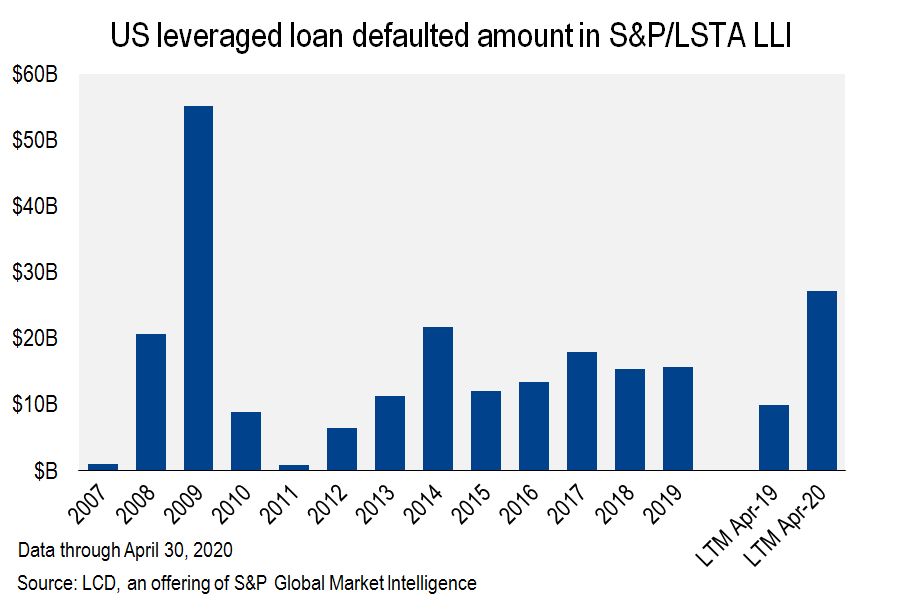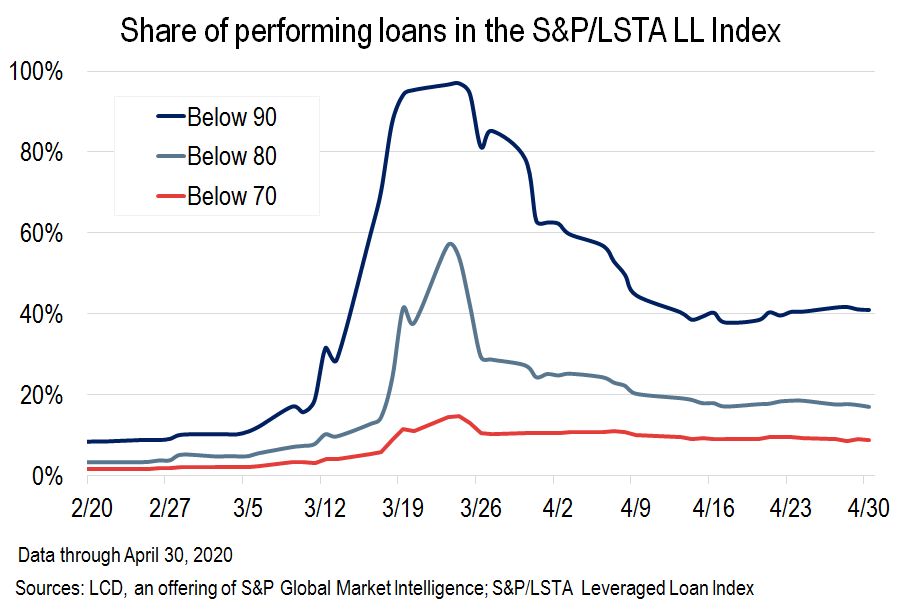The U.S. leveraged loan market, which over the long-running, just-ended credit cycle managed to skirt wide-scale defaults thanks to borrower-friendly deal structures and strong corporate earnings, is proving no match for today's coronavirus environment.
There were 11 defaults from loan issuers in April, the most ever during a month, exceeding the previous record of 10 in October 2009, in the wake of the last major financial crisis, according to the S&P/LSTA Index.
While perhaps not unexpected, the relative flood of defaults was dramatic. April's tally was more than during the entirety of 2020's first quarter, and with grim forward economic indicators thanks to the COVID-19 pandemic, market sources expect more defaults ahead.
Despite the surge in April, the current default rate of 2.32% (by amount outstanding) remains below the historical average of 2.90%, according to the Index. That is testimony to just how low the U.S. loan default rate has been over the past credit cycle. Nonetheless, the April 2020 number is the highest since April 2018. By number of defaults, the current 2.71% default rate is the highest since December 2010.
 |
More broadly, the amount of defaulted loan volume over the past 12 months — $27.18 billion — is 172% ahead of the pace seen during the previous period, and represents the highest such amount since April 2010. The tally is just ahead of February 2015's total. And that number is an outlier, as it largely comprises some $20 billion from the default of one deal, that of Energy Future Holdings Corp.
The default rate is calculated on a rolling 12-month basis, meaning default totals and averages take into account defaults over the prior 12 months.
 |
Across sectors, Telecommunications contributed the highest default volume in April, with two issuers — dominated by Frontier Communications Corp. — defaulting for a combined $2.3 billion, or 33%. Oil & Gas, Healthcare, Leisure, and Business Equipment & Services also saw two defaults apiece.
 |
Through April 30, the Oil & Gas sector has far exceeded others for default activity in 2020, representing a 30.5% share and totaling nearly $6 billion.
Defaults rising
With the dust settling on loan volatility, for now at least, forward measures show the market is clearly pricing in elevated default rates, with the volume of loans below the anecdotal 80-cents-on-the-dollar measure of distress more than three times higher than where it stood before the March sell-off.
Weakest links, another leading indicator, also saw a dramatic increase in the first quarter. Loan Weakest Links are issuers with a corporate credit rating of B-minus or lower from S&P Global Ratings, along with a negative outlook. Historically, increased numbers of Weakest Links have pointed toward increased default activity.
Turning to market-based measures: Secondary loans settled into a “new normal” in April, with leveraged loan prices, per the S&P/LSTA Index, averaging 85 cents on the dollar for the month, nearly halving year-to-date losses from the March 23 low of 76, but still heavily discounted from a 96 context at the start of the year.
Consequently, the volume of loans priced in distress has eased from its March 23 peak of $672 billion, or a Distress Ratio of 57%, to $198 billion, or 17%, on April 30. The share below 80 remains significantly higher in April when compared to the $44.5 billion, or 4%, where it stood at the end of last year.
 |
Breaking down the price brackets, following the March sell-off, there have been no loans bid above par at the closing levels since March 13 — a stretch not seen since LCD first tracked this data in 2012.
The share of S&P/LSTA Index loans priced below 90, at 41% on April 30, has steadily decreased from a peak of 97% on March 24, but compares to just 10% at the end of 2019.
The share of loans in deeper distress, below a price threshold of 70, at 9%, remains elevated from where it stood at the end of 2019 (2%).
 |
Among the sectors with a more meaningful Index share (above 1%), Oil & Gas, Retail, and Leisure sport the highest distress ratios.
 |
The impact of the economic shutdown is also playing out in ratings activity, where the ratio of downgrades to upgrades per the loan Index has accelerated at an eye-popping rate, from 3.8x on a rolling three-month basis in February, to 11.4x in March, and 22.1x as of April 30, the highest reading ever in favor of Index downgrades. The rolling three-month count of downgrades jumped to 376, likewise a record.
 |
The current downgrade cycle has also further worsened the ratings mix of the leveraged loan market, with the share of issuers in the S&P/LSTA Index rated B– or lower climbing to 33% as of April 30, the highest reading ever.
In another ominous record, the CLO pain-point of CCC and CC loans made up a staggering 11% of the Index, as of April 30. This compares to just 2.7% five years ago.
 |
While the quality mix of the loan market has clearly weakened over recent years, the recent Federal Reserve–induced rally and rising default fears have also brought price differentiation back in its extremes. As detailed in an April 24 report from LCD, only 21% of single-B loans were bid in the 95–98 bracket as of April 21, versus 62% of BB loans. The 41% differential represented the peak for April, and for comparison, it went all the way down to just half a percentage point during the March sell-off. This dynamic, should it continue, will undoubtedly make funding access even more prohibitive for the companies that need it the most.
Finally, in a measure of the near-term default landscape, LCD's shadow default rate stood at 3.39% as of April 30.
Imminent situations within this calculation include Intelsat SA, with $2.4 billion outstanding across its B3 and B4 loans. The company is operating under a 30-day grace period after it deferred a $125 million interest payment due April 15 on its $2.95 billion of 8.5% senior notes due October 2024. Also, Akorn Inc. has entered into a standstill agreement that could include a Chapter 11 filing.
 |
This article was written by Rachelle Kakouris. Rachelle is a Director in LCD's Research Group.



